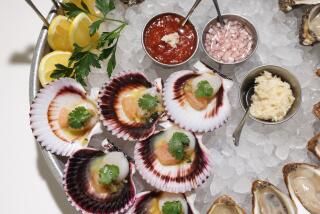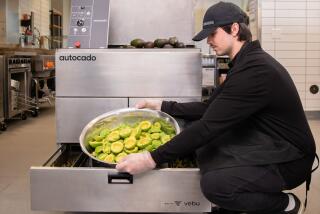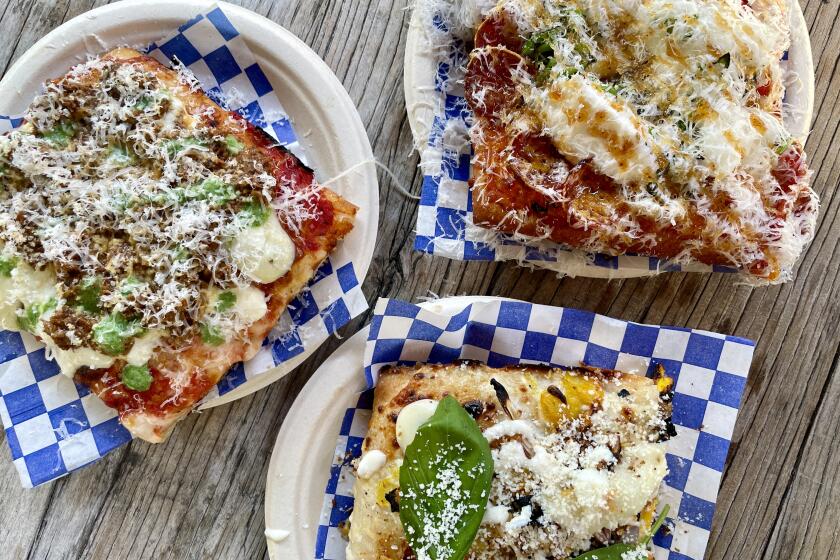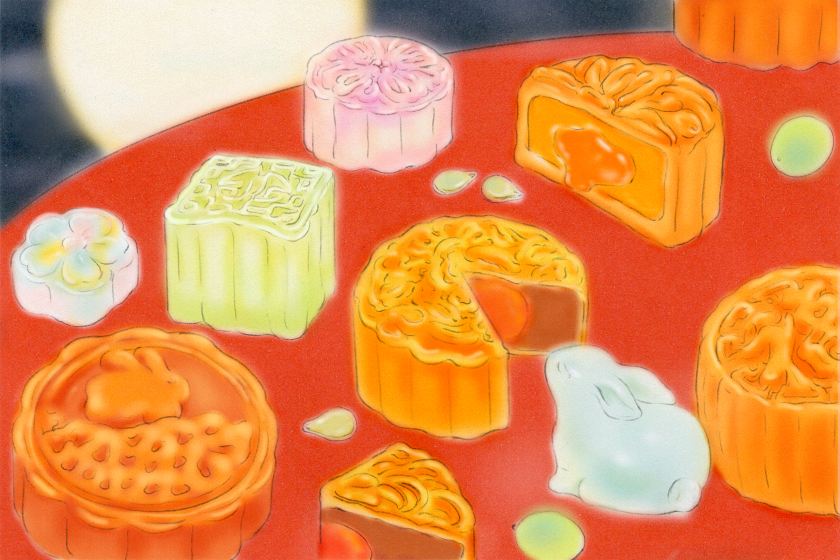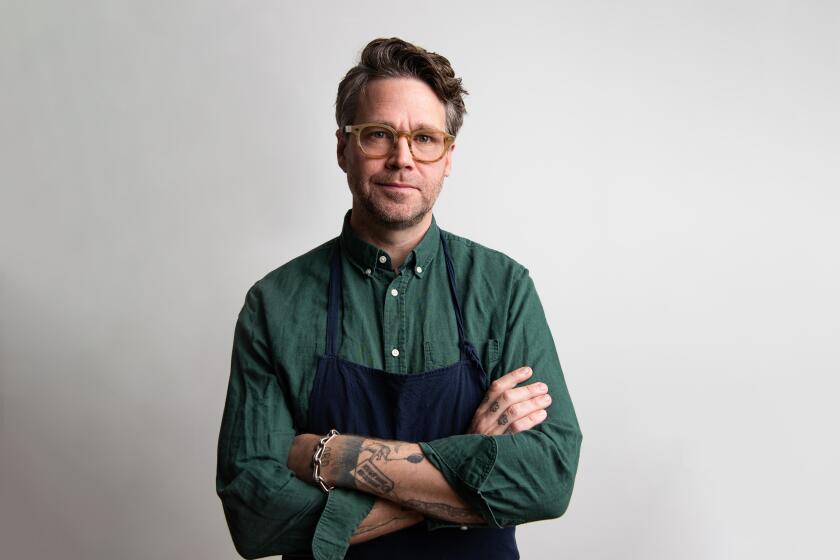Sake rocks it old school
WITH a rush of powerful silky flavors, one sip of Sawanoi Kiokejikomi Iroha sake dramatically overturns your expectations. Unlike the light, dry brews that have been the recent darlings of connoisseurs, this is a full-bodied sake -- complex and bright with yeasty, meaty flavors, notes of lemon and a marvelous but faint cedar backbeat.
Fermented in traditional cedar barrels, it’s one of the finest examples of kimoto sake. The return of kimoto -- made the way all sake was once made -- is part of the trend toward robust, richly flavored sakes made using revived artisanal methods and often organic ingredients.
For the record:
12:00 a.m. June 13, 2007 For The Record
Los Angeles Times Wednesday June 13, 2007 Home Edition Food Part F Page 3 Features Desk 0 inches; 33 words Type of Material: Correction
Sake: A May 16 article about sake said that Sawanoi Kiokejikomi Iroha sake was also listed and misspelled as Sawanoi Junmai Gunjo. Sawanoi Junmai Ginjo is a different sake from the same producer.
For The Record
Los Angeles Times Wednesday June 13, 2007 Home Edition Main News Part A Page 2 National Desk 1 inches; 39 words Type of Material: Correction
Sake: A May 16 Food section article about sake said that Sawanoi Kiokejikomi Iroha sake is sometimes listed as Sawanoi Junmai Gunjo. The correct spelling is Sawanoi Junmai Ginjo, and it is a different sake from the same producer.
These more assertive sakes possess a depth and range of flavors that industrially produced brews never develop. And as the Japanese diet has become richer, and sake has gained an audience worldwide, kimoto and other robust sakes have gained popularity because they can be paired with more kinds of foods than lighter, more delicate sakes.
Beau Timken, proprietor of True Sake in San Francisco, the first all-sake store in the U.S., says full-bodied sakes are the next frontier for aficionados. “These have the flavor dexterity needed, now that sake is seen as a drink to match up with many kinds of food,” he says.
To add an extra measure of boldness to their sakes, artisanal sake breweries, or kuras, are experimenting with a variety of techniques that hadn’t been used since before World War II. They are fermenting sakes in old-fashioned cedar barrels instead of standard enamel-lined, stainless-steel tanks.
They are producing unfiltered sakes, organic sakes, sakes made from sprouted brown rice and sakes brewed with slower, labor-intensive fermentation techniques. And they’re working with little-known yeast strains and heirloom rice varieties.
*
Handcrafted process
PERHAPS the most intricate of the revived techniques is the centuries-old handcrafted process known as the kimoto method, which died out in the early 1900s. To make kimoto sake, brewers create their starter yeast mash without relying on commercially produced lactic acid to speed things up.
When the kimoto mash develops naturally, there’s a give and take between the yeast and bacteria until the yeast prevails. The result is gamy, yeasty undertones adding complexity to the brew.
The kimoto method may be used for most sake categories, including junmais, or pure rice sakes; daiginjos, or super-premium sakes; and ginjos, or premium sakes. (Sake style categories, a sometimes confusing welter of designations, provide information about, among other things, whether alcohol has been added and how much of the rice grain is polished away before steaming and fermenting.)
Daishichi, a kura in the northern prefecture of Fukushima, may have been the brewer to inspire the modern kimoto-style revival with its Minowamon kimoto junmai daiginjo. But this 300-year-old sake maker did more than simply bring back the method. It came up with “super flat” rice polishing, a technique that eliminates more of the grain’s impurities. Its resulting sakes -- unlike traditional varieties that tended to be a bit syrupy and funky -- had amazing clarity yet also the complexity of kimoto-style brews.
Another brand that paved the way for the kimoto revival, Kodama Brewing Co.’s Taiheizan, made in Akita prefecture, won acclaim for its daiginjo kimoto sake as well as for its explosive junmai kimoto, “Grand Mountain.” Its slightly less labor-intensive modification of the kimoto technique resulted in Akita-ryu kimoto, or Akita-style kimoto.
Every year the availability of kimoto sakes continues to expand. The few mentioned here illustrate just how much their styles can vary.
From Yamagata prefecture comes Hatsumago kimoto junmai. Its luscious aromas may be attributed to the unique yeast of Yamagata, a strain that clearly has thrived in the northern region’s deeply cold winters.
For a rustic kimoto sake, Kurosawa junmai kimoto is a choice that fares well served warm or cold. Its origins in Nagano prefecture, a region known for its consumption of wild game, may be why the sake pairs so well with grilled and fried foods, the sort of accompaniments likely to turn up in a country-style izakaya, or pub.
Although traditional methods and ingredients are prized for the elegance they can bring to sake, few kuras are dispensing with their modern technology. Automatic rice cookers and computer-controlled temperature for the brew tanks, among other things, are still viewed as essential.
Brew masters no longer sleep by their tanks as was done for centuries, to awaken in the middle of the night to check the temperature of the fermenting sake.
The decades after World War II were an era that profoundly changed the fate of Japanese sake. Brutal postwar food shortages meant that table rice instead of sakami (sake-grade rice) took precedence. Brewers fortified their sakes with glucose and cheap alcohol.
Many traditional techniques went by the wayside. And sake’s reputation foundered as many small regional kuras closed and others grew more industrial. Meanwhile, the Japanese public developed a fondness for beer and other alcoholic beverages.
The prosperity of the late 1970s brought a renaissance for unadulterated sakes. The movement, comparable to the microbrewery boom in the U.S., inspired kuras both large and small to finesse their sake methods and to bring new and memorable varieties to market.
Yuji Matsumoto, sake sommelier at Tokyo Table in Beverly Hills, confirms the emerging preference for full-bodied sakes, and points out that other techniques besides the kimoto method are used to create elegant versions. Some kuras make unfiltered brews, such as Nanbu Bijin, a special junmai from Iwate. Based on Gin Otomi, a locally grown rice, Nanbu Bijin has a golden color and melony flavors.
Narutotai from Tokushima is made using the yamahai method, a slightly more modern version of kimoto.
The brewer has amplified the sake’s already compound nature introduced by a slow-growing starter mash. Kikumasamune Honkano sake also gilds the kimoto lily. Its brew master adds a smidgen of fine rice alcohol, a touch that gives his perfumy brew added kick.
The ascendancy of bold, audacious sakes in Japan may have begun as a response to that country’s ever more cosmopolitan eating habits, but it’s a trend that has a natural foothold here in Southern California, where more and more non-Japanese restaurants are adding not only sakes, but bold sakes to their wine lists.
And why not? With these big, full-bodied styles, sommeliers can suggest some that will pair as brilliantly with lamb chops or duck as their more delicate counterparts do with sushi and tofu.
*
*
(BEGIN TEXT OF INFOBOX)
Where to find interesting sakes
ARTISANAL sakes including interesting robust styles such as kimoto sakes are available at fine wine retailers, restaurants and Japanese markets. The following sources have extensive selections, helpful staffers and/or special programs. At smaller retailers, the selection can change frequently.
Retail stores
Beverages & More. Store locations at bevmo.com. About 30 to 40 sakes; artisan and large producers.
Marukai Markets. All branches carry sakes from artisan and large producers. Gardena, (310) 660-6300, has more than 80 sakes. Little Tokyo, (213) 893-7200, has more than 200. West Covina, (626) 430-0900, and Costa Mesa, (714) 751-8433, each has more than 40; marukai.com.
Mitsuwa Marketplace. All branches carry 30 to 60 sakes from artisan and large producers. Costa Mesa, (714) 557-6699; Little Tokyo, Los Angeles, (213) 687-6699; San Gabriel, (626) 457-2899; Torrance, (310) 782-0335; West Los Angeles (Centinela), (310) 398-2113; mitsuwa.com.
Nijiya Markets. All branches carry sakes from artisan and large producers. Torrance, (310) 366-7200, and West Los Angeles, (310) 575-3300, carry more than 50 sakes. Industry, (626) 913-9991, has more than 30. Little Tokyo, (213) 680-3280, has more than 100; www.nijiya.com.
Silverlake Wine. Los Angeles, (323) 662-9024; silverlakewine.com. An idiosyncratic rotation of eight to 10 sakes; primarily artisan producers.
True Sake. San Francisco, (415) 355-9555; truesake.com. Over 200 sakes; artisan and large producers.
Twenty-Twenty Wines. West Los Angeles, (310) 447-2020; 2020wines.com. Rotating selection of 10 to 12 sakes; primarily artisan producers.
Vendome Wine & Spirits. Store locations at vendomebeverlyhills.com. Branches carry 30 to 50 sakes from large and small producers.
Wally’s Wine & Spirits. Los Angeles, (310) 475-0606; wallywine.com. Changing inventory of about 20 sakes; primarily artisan producers.
Wine House. West Los Angeles, (310) 479-3731; winehouse.com. Rotating selection of 20 to 30 sakes; primarily artisan producers.
Restaurants
Bin 8945. Los Angeles, (310) 550-8945; bin8945.com. A list of 16 sakes by the glass (selection changes), many from artisan producers.
Celadon Galerie Culinaire. Los Angeles, (323) 658-8028; www.celadongalerie.com. More than 45 sakes by the bottle and glass, many from artisan producers.
Hamasaku. West Los Angeles, (310) 479-7636; hamasakula.com. More than 15 sakes; a few artisan labels, by the bottle only.
Izakaya SaSaYa. 11613 Santa Monica Blvd., (310) 477-4404; izakaya-sasaya.com. Fifteen sakes, mostly artisan, by the bottle, carafe or glass, depending on the brand.
Japonica. Redondo Beach, (310) 316-9477; japonicadining.com. About 30 sakes by the glass and bottle; some artisan producers.
Japon Bistro. Pasadena, (626) 744-1751; japonbistro-pasadena.com. More than 25 sakes by the glass and bottle; artisan and large producers.
Katana. Los Angeles, (323) 650-8585; sushiroku.com. More than 60 sakes by bottle and glass, many from artisan producers.
Mako. Beverly Hills, (310) 288-8338; makorestaurant.com. About 20 sakes by the glass, half-bottle and bottle; half from artisan producers.
Tengu. Westwood, (310) 209-0071; tengu.com. About two dozen sakes by the glass, bottle and carafe, several from artisan producers.
Tokyo Table. Beverly Hills, (310) 657-9500; tokyotable.com. Rotating selection of 25 sakes by the bottle and glass, many from artisan producers.
Torafuku. West Los Angeles, (310) 470-0014; www.torafuku-usa.com. Fifteen sakes by the bottle and glass; primarily artisan producers.
Uerukamu. Tarzana, (818) 609-0993. 30 to 35 sakes by the bottle; some artisan producers.
-- Linda Burum, Jenn Garbee and Ed Stockly
**
A rich array of kimotos
SEVERAL different styles of sakes are made using the kimoto method, so the word “kimoto” may be just one of two or three indicators on a bottle label. But rich, complex kimotos are becoming more widely available (see accompanying box) and are well worth seeking out. Here are some examples.
Sawanoi Kiokejikomi Iroha. From the Ozawa brewery in Tokyo, this cedar-barrel fermented sake (also listed as Sawanoi Junmai Gunjo) is absolutely elegant. It has the best attributes of several sake styles in one bottle -- a little fruit from the highly polished rice and a gutsy earthiness from the moto (starter culture) blended in one silky sip. You don’t taste the wood outright; it’s hidden among subtle yeasty, meaty flavors and balanced by lemon-like under notes. Very full bodied. Available at Mitsuwa Marketplace, Little Tokyo, ($38 for 1.8 liters) and True Sake, truesake.com ( $44 for 720 ml.)
Hatsumago Kimoto Junmai. This subtle brew from Tohoku Meijo brewery in Yamagata shows just how complex kimoto junmai sakes can be. At first it is light, smooth and almost wine-like. But stay with it awhile and you notice its subtle earthy nuances too. Apparently, the special Yamagata yeast that fosters it is part of its secret. Available at Mitsuwa Marketplace, Little Tokyo, and Marukai Market, Gardena (about $38 for 1.8 liters).
Funaguchi Ichiban Shibori. From Kikusui in Nigata. It may not seem suave to pour your sake from an aluminum can, but that vessel is the best way to preserve this unpasteurized and unfiltered draft genshu (undiluted, 20% alcohol sake) that is stored refrigerated. Even so, the live culture continues to change this potent brew as it passes through a wine-like phase to a state almost resembling brandy. Initially, the flavor is slightly ricey and fruity, balanced by the big wallop of alcohol. Try it with grilled meat, kushi-yaki (skewered foods) or seared toro. Available at Mitsuwa Marketplace, Little Tokyo (about $46 for 1.8 liters, $25 for 720 ml.); truesake.com (about $28 for 720 ml.); and Tokyo Table restaurant, Beverly Hills (about $11 for 300 ml.).
Kimoto “Grand Mountain.” Here is a classic, well constructed kimoto method junmai from Taiheizan in Akita. It greets you with a strong presence and an almost creamy feel. Smooth texture, ample acidity and a long finish with hints of fruit. Available at truesake.com (about $21 for 720 ml.).
Junmai Ginjo Genshu. For those who like their flavors really big, this (kimoto variation) yamahai-style genshu from Narutotai in Tokushima packs enough punch to stand up to steaks and even barbecue. Sweetness and acidity compete, one never overpowering the other. The full-bodied feel adds to its impressive presence. At Beverages & More online, www.bevmo.com (about $38 for 720 ml.); and truesake.com (about $42 for 720 ml.).
-- Linda Burum
More to Read
Eat your way across L.A.
Get our weekly Tasting Notes newsletter for reviews, news and more.
You may occasionally receive promotional content from the Los Angeles Times.

